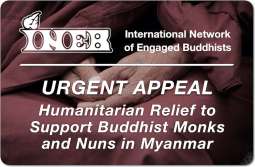Arhat 阿羅漢 There are two kinds of arhats, namely, the Sound-hearing arhat (śrāvaka) and the Enlightened-to-condition arhat (Pratyeka-Buddha). The former attains the wisdom to understand the Four Noble Truth, while the latter attains the wisdom to understand the Law of Dependent Origination or the Twelve Links of Dependent Origination. They represent two vehicles, who "comprehend for their own sake". As they pay attention to themselves and not to others, they are incapable of genuine and equal enlightenment. There are four noble stages of fruition in the Arhat Path.
Arhat[Arahat] a worthy saint. Arhathood is the goal in Theravādin practice in contrast with Bodhisattvahood in the Mahāyāna practice. Ari means enemy. The Sanskrit root han means to kill. An Arhat has slain the enemies which are in the form of greed, anger and delusion. Hence he is known as Arhat. The stage of an Arhat is the fourth stage of holiness. It is the highest rank attained by
śrāvaka-s.
An Arhat has attained enlightenment and is no longer subject to the cycle of birth and death. However, there is a difference between a Buddha and an Arhat. A Buddha is omniscient; he possesses perfect knowledge of everything, while the Arhat does not possess complete knowledge. A Buddha is a promulgator of the true doctrine that is dharma while an Arhat is only a follower of the same. As far as emancipation (vimukti) is concerned, the Theravādin contention is that there is no difference between a Buddha and an Arhat in this regard.
The characteristics of an Arhat are defined by the Buddha when he says, "Herein O Bhikkhu-s, a bhikkhu is an Arhat, one who has destroyed the defilements, who has lived the life, done what was to be done, laid aside the burden, who has attained his goal, who has destroyed the fetters of existence, who... is delivered. His five sense organs still remain and as he is not devoid of them, he undergoes the pleasant and the unpleasant experience. That destruction of his attachment, hatred and delusion is called 'the element of nibbāna with the basis still remaining'. He has overcome all doubts about the triratna, namely, the Buddha, his teachings and the Order; non-existence of soul; and the law of causation. Though little, he recites the sacred texts, but acts in accordance with the teachings, refrains from lust, hatred and ignorance, truly knowing, with mind well freed, clinging to naught here and hereafter, he shares the fruits of the Holy Life. Though emancipated, it is because of the karmic force which produced his birth, the life-span is still not exhausted; he is alive without adding fresh karma."
An Arhat is called aśaikṣa, that is, he who does not no more subject to training. An anāgāmī and an Arhat who has developed rūpa and ārūpya dhyāna-s, that is, concentrations in the realm of form and formless realm, can experience the Nibbānic bliss uninterruptedly as long as seven days even in this life.
In Chinese Buddhism the Ch'an school venerated the Arhat-s as beings corresponding to the mind of Ch'an. They were attributed magical powers.
arhat: ‘AWorthy One', epithet for one who has achieved the highest spiritual attainment.
árhat mfn. deserving, entitled to (acc.) RV
• used in a respectful address for arhasi Pāṇ. 3-2, 133, able, allowed to (acc.) RV
• worthy, venerable, respectable ŚBr. AitBr. &c. ( arhat-tama below)
• praised, celebrated L
• (an), m. a Buddha who is still a candidate for Nirvāṇa
• (= kṣapaṇaka) a Jaina
• an Arhat or superior divinity with the Jainas
• the highest rank in the Buddhist hierarchy L
【梵】arhat
【滿】bata be etehe
【蒙】daiin ig darugsan
【漢】應供













